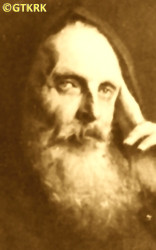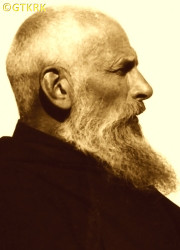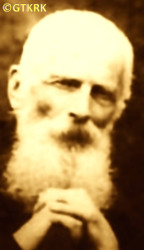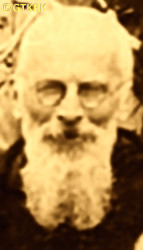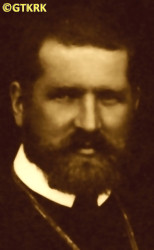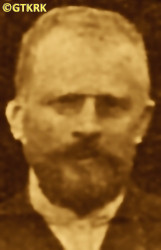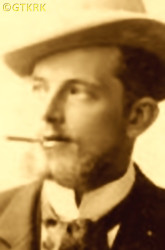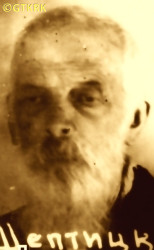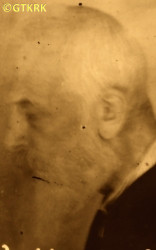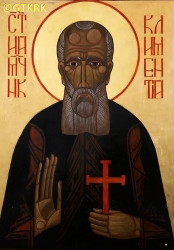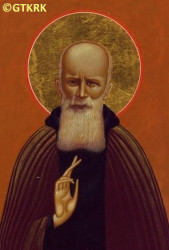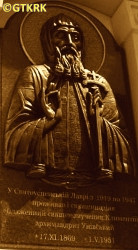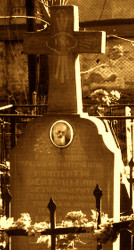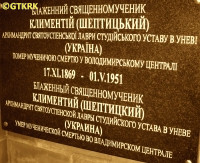Roman Catholic
St Sigismund parish
05-507 Słomczyn
85 Wiślana Str.
Konstancin deanery
Warsaw archdiocese, Poland
full list:
displayClick to display full list

searchClick to search full list by categories
wyświetlKliknij by wyświetlić pełną listę po polsku

szukajKliknij by przeszukać listę wg kategorii po polsku

Martyrology of the clergy — Poland
XX century (1914 – 1989)
personal data
religious status
blessed
surname
SZEPTYCKI
forename(s)
Casimir Mary (pl. Kazimierz Maria)
religious forename(s)
Clement (pl. Klemens)
beatification date
27.06.2001more on
www.swzygmunt.knc.pl
[access: 2013.05.19]

the RC Pope John Paul IImore on
en.wikipedia.org
[access: 2014.09.21]
function
religious cleric
creed
Ukrainian Greek Catholic GCmore on
en.wikipedia.org
[access: 2013.05.19]
congregation
Studite Brethren MSUmore on
en.wikipedia.org
[access: 2013.05.19]
(i.e. Studites)
diocese / province
Lviv GC archeparchymore on
en.wikipedia.org
[access: 2013.05.19]
academic distinctions
Doctor of Law
honorary titles
„Polonia Restituta” Cross — 3rd Class, Commander'smore on
en.wikipedia.org
[access: 2019.04.16]
(13.11.2008)
Righteous Among the Nationsmore on
en.wikipedia.org
[access: 2020.09.24]
(1995)
date and place
of death
01.05.1951

VladimirVladimir on the Klyazma River
today: Vladimir city reg., Vladimir oblast, Russia
more on
en.wikipedia.org
[access: 2022.01.06]
details of death
After German and Russian invasion of Poland in 09.1939 and start of the II World, after start of occupation of eastern Poland in 09.1939 by the Russians and finally after German attack on 22.06.1941 of their erstwhile ally, Russians, during German genocide of the Jews gave shelter and hid young Jewish children.
Organised transfer of Jews to Carpathian Ruthenia then in Hungary.
After German defeat in the World War II and start in 1944/1945 of another Russian occupation of pre‐war Polish eastern provinces (voivodships), attempted to negotiate with Russians in Moscow — representing Joseph Slipyi, new Greek Catholic Lviv archbishop.
After arrest on 11.04.1945 by the Russians of almost all Greek Catholic bishops, de facto informal leader of Greek Catholics on Russian–occupied territories.
Author of a letter from 01.07.1945, signed by 61 Greek Catholic priests, in defence of arrested bishops and demanding a stop to persecution of the Church.
As a result expelled by the Russians from Lviv.
Returned to his monastery in Univ.
On 05.06.1947 — after delegalisation of the Greek Catholi church on 08‐10.03.1946 — arrested by the Russians in his monk's cell.
Held in Łącki Str. prison in Lviv, and next from 05.07.1947 in Lyukyanivska prison in Kiev.
Repeatedly interrogated and tortured.
On 28.02.1948 for „collaboration with Vatican and anti–Russian activities” sentenced to 8 years of prison and slave labour in Russian concentration camp — Gulag.
Brought to Vladimir on Klazma prison where perished.
cause of death
extermination
perpetrators
Russians
sites and events
Vladimir (on Klaźma river)Click to display the description, Kiev (Lyukyanivska)Click to display the description, Lviv (Łąckiego)Click to display the description, Help to the JewsClick to display the description, Ribbentrop‐MolotovClick to display the description, Pius XI's encyclicalsClick to display the description
date and place
of birth
17.11.1869

Prylbychitoday: Novoiavorivsk urban hrom., Yavoriv rai., Lviv obl., Ukraine
more on
en.wikipedia.org
[access: 2023.03.02]
parents
SZEPTYCKI John Cantius
🞲 1836, Prylbychitoday: Novoiavorivsk urban hrom., Yavoriv rai., Lviv obl., Ukraine
more on
en.wikipedia.org
[access: 2023.03.02] — 🕆 1912, Prylbychitoday: Novoiavorivsk urban hrom., Yavoriv rai., Lviv obl., Ukraine
more on
en.wikipedia.org
[access: 2023.03.02]

FREDRO Sophia
🞲 1837, Lvivtoday: Lviv urban hrom., Lviv rai., Lviv obl., Ukraine
more on
en.wikipedia.org
[access: 2022.01.16] — 🕆 1904, Prylbychitoday: Novoiavorivsk urban hrom., Yavoriv rai., Lviv obl., Ukraine
more on
en.wikipedia.org
[access: 2023.03.02]
religious vows
1913 (temporary)
presbyter (holy orders)
ordination
28.08.1915

positions held
1946 – 1947
monk — Univtoday: Peremyshliany urban hrom., Lviv rai., Lviv obl., Ukraine
more on
en.wikipedia.org
[access: 2022.12.13] ⋄ Studites MSU ⋄ Dormition of the Blessed Virgin Mary GC monastery (Lavra)
from 1944
Archimandrite, i.e. superior abbot — monasteries (in the Lviv archieparchy), Studites MSU
1944 – 1946
monk — Kryvchytsitoday: district of Lviv, Lviv urban hrom., Lviv rai., Lviv obl., Ukraine
more on
uk.wikipedia.org
[access: 2022.12.13] ⋄ Studites MSU ⋄ St John the Baptist GC monastery (Lavra) — prob.
1941 – c. 1944
hegumen–superior — Univtoday: Peremyshliany urban hrom., Lviv rai., Lviv obl., Ukraine
more on
en.wikipedia.org
[access: 2022.12.13] ⋄ Studites MSU ⋄ Dormition of the Blessed Virgin Mary GC monastery (Lavra)
from 1939
exarch – patriarch's legate — Russia, including Siberia, Greek Catholic Church — prob. appointed clandestinely
1937 – 1941
monk — Kryvchytsitoday: district of Lviv, Lviv urban hrom., Lviv rai., Lviv obl., Ukraine
more on
uk.wikipedia.org
[access: 2022.12.13] ⋄ Studites MSU ⋄ St John the Baptist GC monastery (Lavra) — collaborator of the Greek Catholic Archbishop of Lviv, Andrew Szeptycki
1926 – 1937
hegumen–superior — Univtoday: Peremyshliany urban hrom., Lviv rai., Lviv obl., Ukraine
more on
en.wikipedia.org
[access: 2022.12.13] ⋄ Studites MSU ⋄ Dormition of the Blessed Virgin Mary GC monastery (Lavra) — co‐author of the monastic rule „Typicon” (1936‐1937);; also: lecturer at the University of Innsbruck
1919 – 1926
monk — Univtoday: Peremyshliany urban hrom., Lviv rai., Lviv obl., Ukraine
more on
en.wikipedia.org
[access: 2022.12.13] ⋄ Studites MSU ⋄ Dormition of the Blessed Virgin Mary GC monastery (Lavra)
1913 – 1919
student — Innsbrucktoday: Innsbruck‐Land dist., Tyrol state, Austria
more on
en.wikipedia.org
[access: 2024.03.19] ⋄ Department of Theology, Leopold and Francis University — resident at Jesuit Canisianum College
1912 – 1913
novitiate — Kamenicatoday: Čelinac can., Republika Srpska ent., Bosnia and Herzegovina
more on
en.wikipedia.org
[access: 2022.12.13] ⋄ Studites MSU ⋄ St Joseph Spouse of the Blessed Virgin Mary GC monastery
1912
accession — Studites MSU
1911 – 1912
novitiate — Beurontoday: Sigmaringen dist., Tübingen reg., Baden‐Württemberg state, Germany
more on
en.wikipedia.org
[access: 2022.04.12] ⋄ St Martin Archabbey, Benedictines OSB
1911
accession — Benedictines OSB
1900 – 1911
activist — i.a. member of the District Council in Bóbrka (1910‐1911), president of the Galician Forestry Society (1907‐1911), member of the National Railway Council (1910‐1911), activist of the Galician Farming Society, member of its ruling Committee (1903‐1910) and vice–president (1910‐1912)
1900 – 1907
parliamentary deputy — Viennatoday: Vienna state, Austria
more on
en.wikipedia.org
[access: 2020.07.31] ⋄ Germ. Reichsrat (Eng. Imperial Council), Cisleithania, i.e. northern and western part of Empira, Austro–Hungarian Empire — on behalf of the „Podolacy” group, i.e. eastern Galician conservatives, from the Przemyśl–Jarosław constituency, in the eastern part of the crown land of Galicia and Lodomeria; member of the Social and Political, Agricultural and Customs Committees; rapporteur of the proposed law introducing pension insurance for public and private employees; co‐author of the Austrian „General Forest Law”
till 1892
PhD student — Krakówtoday: Kraków city pov., Lesser Poland voiv., Poland
more on
en.wikipedia.org
[access: 2021.06.07] ⋄ law, Jagiellonian University UJ — title Lat. „Iuris Utriusque Doctor” (Eng. „Doctor of Both Laws”) granted on 16.07.1892; also: at the same time a student of the „Institute of Forestry”
from 1890
resident — Devyatnykytoday: Khodoriv urban hrom., Stryi rai., Lviv obl., Ukraine
more on
uk.wikipedia.org
[access: 2022.12.13] — manager of the family estate, which, apart from Devyatnyky, where the family manor was located, also included the villages of Kolohory and Yatvyagi
student — Paristoday: Paris dep., Île‐de‐France reg., France
more on
en.wikipedia.org
[access: 2020.11.13] ⋄ law
1889 – 1890
student — Viennatoday: Vienna state, Austria
more on
en.wikipedia.org
[access: 2020.07.31] ⋄ law, Alma Mater Rudolphina Vindobonensis (Eng. University of Vienna), i.e. Rudolphina
1888 – 1889
student — Munichtoday: Bavaria state, Germany
more on
en.wikipedia.org
[access: 2022.04.12] ⋄ law, Germ. Ludwig–Maximilians–Universität (Eng. Ludwig Maximilian University)
from 1887
student — Krakówtoday: Kraków city pov., Lesser Poland voiv., Poland
more on
en.wikipedia.org
[access: 2021.06.07] ⋄ law, Jagiellonian University UJ
membership — Lvivtoday: Lviv urban hrom., Lviv rai., Lviv obl., Ukraine
more on
en.wikipedia.org
[access: 2022.01.16] ⋄ Theological Scientific Society
others related
in death
REINYSClick to display biography Mieczyslav, JANULAITISClick to display biography Francis, LAUKAITISClick to display biography Joseph, MATULIONISClick to display biography Theophilus, MIRONASClick to display biography Vladislav
sites and events
descriptions
Vladimir (on Klaźma river): On of the harshest Russian prisons for political prisoners where dozens of catholic priest were held.
Kiev (Lyukyanivska): Russian political prison in Kiev, in the first half of 20th century run by the genocidal NKVD, informally referred to as prison No 1, formally as Investigative Prison No 13 (SIZO#13). It was founded in the early 19th century. In the 20th century, during the Soviet times, the prison church was transformed into another block of cells. During the reign of J. Stalin in Russia, more than 25,000 prisoners passed through it. (more on: en.wikipedia.orgClick to attempt to display webpage
[access: 2014.09.21])
Lviv (Łąckiego): Prison at Łącki Str. in Lviv. Founded in 1918‐1920 by Polish authorities, mainly for political prisoners. From 1935 used as investigative jail. After German and Russian invasion of Poland in 09.1939 and start of the World War II, after start of Russian occupation Russians — local branch of Russian genocidal NKVD organisation — held thousands of prisoners, mainly Poles and Ukrainians, in prison (then prison no 1). It was also a place of carrying out death sentences passed by Russian summary courts on Poles suspected of participation in Polish clandestine resistance activities. In 06.1941, after German attack on 22.06.1941 of their erstwhile ally, Russians, NKVD agents slaugher — during genocidal massacres of prisoners — c. 924 inmates. During German occupation that followed in 1941‐1944 the prison’s buildings held German Gestapo investigative jail. It was a place of executions. In 1944‐1991, after German defeat and start of another Russian occupation, the building were again used by NKVD (and it successor MVD) as investigative jail and also investigative department. (more on: pl.wikipedia.orgClick to attempt to display webpage
[access: 2014.10.31])
Help to the Jews: During World War II on the Polish occupied territories Germans forbid to give any support to the Jews under penalty of death. Hundreds of Polish priests and religious helped the Jews despite this official sanction. Many of them were caught and murdered.
Ribbentrop‐Molotov: Genocidal Russian‐German alliance pact between Russian leader Joseph Stalin and German leader Adolf Hitler signed on 23.08.1939 in Moscow by respective foreign ministers, Mr. Vyacheslav Molotov for Russia and Joachim von Ribbentrop for Germany. The pact sanctioned and was the direct cause of joint Russian and German invasion of Poland and the outbreak of the World War II in 09.1939. In a political sense, the pact was an attempt to restore the status quo ante before 1914, with one exception, namely the „commercial” exchange of the so‐called „Kingdom of Poland”, which in 1914 was part of the Russian Empire, fore Eastern Galicia (today's western Ukraine), in 1914 belonging to the Austro‐Hungarian Empire. Galicia, including Lviv, was to be taken over by the Russians, the „Kingdom of Poland” — under the name of the General Governorate — Germany. The resultant „war was one of the greatest calamities and dramas of humanity in history, for two atheistic and anti‐Christian ideologies — national and international socialism — rejected God and His fifth Decalogue commandment: Thou shall not kill!” (Abp Stanislav Gądecki, 01.09.2019). The decisions taken — backed up by the betrayal of the formal allies of Poland, France and Germany, which on 12.09.1939, at a joint conference in Abbeville, decided not to provide aid to attacked Poland and not to take military action against Germany (a clear breach of treaty obligations with Poland) — were on 28.09.1939 slightly altered and made more precise when a treaty on „German‐Russian boundaries and friendship” was agreed by the same murderous signatories. One of its findings was establishment of spheres of influence in Central and Eastern Europe and in consequence IV partition of Poland. In one of its secret annexes agreed, that: „the Signatories will not tolerate on its respective territories any Polish propaganda that affects the territory of the other Side. On their respective territories they will suppress all such propaganda and inform each other of the measures taken to accomplish it”. The agreements resulted in a series of meeting between two genocidal organization representing both sides — German Gestapo and Russian NKVD when coordination of efforts to exterminate Polish intelligentsia and Polish leading classes (in Germany called «Intelligenzaktion», in Russia took the form of Katyń massacres) where discussed. Resulted in deaths of hundreds of thousands of Polish intelligentsia, including thousands of priests presented here, and tens of millions of ordinary people,. The results of this Russian‐German pact lasted till 1989 and are still in evidence even today. (more on: en.wikipedia.orgClick to attempt to display webpage
[access: 2015.09.30])
Pius XI's encyclicals: Facing the creation of two totalitarian systems in Europe, which seemed to compete with each other, though there were more similarities than contradictions between them, Pope Pius XI issued in 03.1937 (within 5 days) two encyclicals. In the „Mit brennender Sorge” (Eng. „With Burning Concern”) published on 14.03.1938, condemned the national socialism prevailing in Germany. The Pope wrote: „Whoever, following the old Germanic‐pre‐Christian beliefs, puts various impersonal fate in the place of a personal God, denies the wisdom of God and Providence […], whoever exalts earthly values: race or nation, or state, or state system, representatives of state power or other fundamental values of human society, […] and makes them the highest standard of all values, including religious ones, and idolizes them, this one […] is far from true faith in God and from a worldview corresponding to such faith”. On 19.03.1937, published „Divini Redemptoris” (Eng. „Divine Redeemer”), in which criticized Russian communism, dialectical materialism and the class struggle theory. The Pope wrote: „Communism deprives man of freedom, and therefore the spiritual basis of all life norms. It deprives the human person of all his dignity and any moral support with which he could resist the onslaught of blind passions […] This is the new gospel that Bolshevik and godless communism preaches as a message of salvation and redemption of humanity”… Pius XI demanded that the established human law be subjected to the natural law of God , recommended the implementation of the ideal of a Christian state and society, and called on Catholics to resist. Two years later, National Socialist Germany and Communist Russia came together and started World War II. (more on: www.vatican.vaClick to attempt to display webpage
[access: 2023.05.28], www.vatican.vaClick to attempt to display webpage
[access: 2023.05.28])
sources
personal:
tsn.uaClick to attempt to display webpage
[access: 2019.10.13], pl.wikipedia.orgClick to attempt to display webpage
[access: 2013.05.19]
original images:
prylbychi-ugcc.at.uaClick to attempt to display webpage
[access: 2019.10.13], sprawiedliwi.org.plClick to attempt to display webpage
[access: 2019.10.13], uk.wikipedia.orgClick to attempt to display webpage
[access: 2019.10.13], dyvensvit.orgClick to attempt to display webpage
[access: 2019.10.13], sprawiedliwi.org.plClick to attempt to display webpage
[access: 2019.10.13], photo-lviv.in.uaClick to attempt to display webpage
[access: 2019.10.13], pl.wikipedia.orgClick to attempt to display webpage
[access: 2019.10.13], sprawiedliwi.org.plClick to attempt to display webpage
[access: 2019.10.13], sprawiedliwi.org.plClick to attempt to display webpage
[access: 2019.10.13], tsn.uaClick to attempt to display webpage
[access: 2019.10.13], www.facebook.comClick to attempt to display webpage
[access: 2019.10.13], sprawiedliwi.org.plClick to attempt to display webpage
[access: 2019.10.13], commons.wikimedia.orgClick to attempt to display webpage
[access: 2019.10.13], uk.wikipedia.orgClick to attempt to display webpage
[access: 2019.10.13], www.moskwa.msz.gov.plClick to attempt to display webpage
[access: 2014.05.09], commons.wikimedia.orgClick to attempt to display webpage
[access: 2019.10.13], ipn.gov.plClick to attempt to display webpage
[access: 2019.02.02]
LETTER to CUSTODIAN/ADMINISTRATOR
If you have an Email client on your communicator/computer — such as Mozilla Thunderbird, Windows Mail or Microsoft Outlook, described at WikipediaPatrz:
en.wikipedia.org, among others — try the link below, please:
LETTER to CUSTODIAN/ADMINISTRATORClick and try to call your own Email client
If however you do not run such a client or the above link is not active please send an email to the Custodian/Administrator using your account — in your customary email/correspondence engine — at the following address:

giving the following as the subject:
MARTYROLOGY: SZEPTYCKI Casimir Mary
To return to the biography press below:
 Click to return to biography
Click to return to biography








